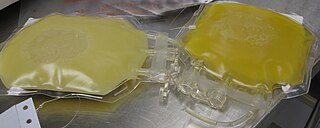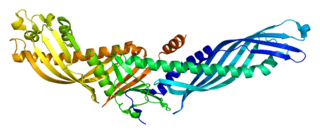
Low-density lipoprotein (LDL) is one of the five major groups of lipoprotein that transport all fat molecules around the body in extracellular water. These groups, from least dense to most dense, are chylomicrons, very low-density lipoprotein (VLDL), intermediate-density lipoprotein (IDL), low-density lipoprotein (LDL) and high-density lipoprotein (HDL). LDL delivers fat molecules to cells. LDL has been associated with the progression of atherosclerosis.

Metabolic syndrome is a clustering of at least three of the following five medical conditions: abdominal obesity, high blood pressure, high blood sugar, high serum triglycerides, and low serum high-density lipoprotein (HDL).

In pharmacology, the fibrates are a class of amphipathic carboxylic acids and esters. They are derivatives of fibric acid. They are used for a range of metabolic disorders, mainly hypercholesterolemia, and are therefore hypolipidemic agents.

Hypercholesterolemia, also called high cholesterol, is the presence of high levels of cholesterol in the blood. It is a form of hyperlipidemia, hyperlipoproteinemia, and dyslipidemia.
Dyslipidemia is a metabolic disorder characterized by abnormally high or low amounts of any or all lipids or lipoproteins in the blood. Dyslipidemia is a risk factor for the development of atherosclerotic cardiovascular diseases (ASCVD), which include coronary artery disease, cerebrovascular disease, and peripheral artery disease. Although dyslipidemia is a risk factor for ASCVD, abnormal levels don't mean that lipid lowering agents need to be started. Other factors, such as comorbid conditions and lifestyle in addition to dyslipidemia, is considered in a cardiovascular risk assessment. In developed countries, most dyslipidemias are hyperlipidemias; that is, an elevation of lipids in the blood. This is often due to diet and lifestyle. Prolonged elevation of insulin resistance can also lead to dyslipidemia. Likewise, increased levels of O-GlcNAc transferase (OGT) may cause dyslipidemia.

Hypertriglyceridemia is the presence of high amounts of triglycerides in the blood. Triglycerides are the most abundant fatty molecule in most organisms. Hypertriglyceridemia occurs in various physiologic conditions and in various diseases, and high triglyceride levels are associated with atherosclerosis, even in the absence of hypercholesterolemia and predispose to cardiovascular disease.

In medicine, a family history consists of information about disorders of direct blood relatives of the patient. Genealogy typically includes very little of the medical history of the family, but the medical history could be considered a specific subset of the total history of a family. Accurate knowledge of a patient's family history may identify a predisposition to developing certain illnesses, which can inform clinical decisions and allow effective management or even prevention of conditions.

Apolipoproteins are proteins that bind lipids to form lipoproteins. They transport lipids in blood, cerebrospinal fluid and lymph.
Hyperlipidemia is abnormally high levels of any or all lipids or lipoproteins in the blood. The term hyperlipidemia refers to the laboratory finding itself and is also used as an umbrella term covering any of various acquired or genetic disorders that result in that finding. Hyperlipidemia represents a subset of dyslipidemia and a superset of hypercholesterolemia. Hyperlipidemia is usually chronic and requires ongoing medication to control blood lipid levels.

Cholesteryl ester transfer protein (CETP), also called plasma lipid transfer protein, is a plasma protein that facilitates the transport of cholesteryl esters and triglycerides between the lipoproteins. It collects triglycerides from very-low-density (VLDL) or Chylomicrons and exchanges them for cholesteryl esters from high-density lipoproteins (HDL), and vice versa. Most of the time, however, CETP does a heteroexchange, trading a triglyceride for a cholesteryl ester or a cholesteryl ester for a triglyceride.

Apolipoprotein E (Apo-E) is a protein involved in the metabolism of fats in the body of mammals. A subtype is implicated in Alzheimer's disease and cardiovascular diseases. It is encoded in humans by the gene APOE.

Lipoprotein(a) is a low-density lipoprotein variant containing a protein called apolipoprotein(a). Genetic and epidemiological studies have identified lipoprotein(a) as a risk factor for atherosclerosis and related diseases, such as coronary heart disease and stroke.

Apolipoprotein AI(Apo-AI) is a protein that in humans is encoded by the APOA1 gene. As the major component of HDL particles, it has a specific role in lipid metabolism.

Apolipoprotein C-III also known as apo-CIII, and apolipoprotein C3, is a protein that in humans is encoded by the APOC3 gene. Apo-CIII is secreted by the liver as well as the small intestine, and is found on triglyceride-rich lipoproteins such as chylomicrons, very low density lipoprotein (VLDL), and remnant cholesterol.

Apolipoprotein A-V is a protein that in humans is encoded by the APOA5 gene on chromosome 11. It is significantly expressed in liver. The protein encoded by this gene is an apolipoprotein and an important determinant of plasma triglyceride levels, a major risk factor for coronary artery disease. It is a component of several lipoprotein fractions including VLDL, HDL, chylomicrons. It is believed that apoA-V affects lipoprotein metabolism by interacting with LDL-R gene family receptors. Considering its association with lipoprotein levels, APOA5 is implicated in metabolic syndrome. The APOA5 gene also contains one of 27 SNPs associated with increased risk of coronary artery disease.

Lipidology is the scientific study of lipids. Lipids are a group of biological macromolecules that have a multitude of functions in the body. Clinical studies on lipid metabolism in the body have led to developments in therapeutic lipidology for disorders such as cardiovascular disease.
Harry Harris FRS, FCRP was a British-born biochemist. His work showed that human genetic variation was not rare and disease-causing but instead was common and usually harmless. He was the first to demonstrate, with biochemical tests, that with the exception of identical twins we are all different at the genetic level. This work paved the way for many well-known genetic concepts and procedures such as DNA fingerprinting, the prenatal diagnosis of disorders using genetic markers, the extensive heterogeneity of inherited diseases, and the mapping of human genes to chromosomes
Wolfgang Patsch is an Austrian physician, specialized in internal medicine/laboratory medicine and a professor in the Department of Pharmacology and Toxicology at the Paracelsus Private Medical University of Salzburg. He is known for his work in the fields of atherosclerosis, common metabolic disorders such as obesity, insulin resistance and type-2 diabetes and neurodegenerative disorders.
Jan Leslie Breslow is an American physician and medical researcher who studies atherosclerosis. As of 2017, he is Frederick Henry Leonhardt Professor at Rockefeller University and directs the university's Laboratory of Biochemical Genetics and Metabolism.
Jasvinder K Gambhir is an Indian doctor, researcher and professor in the fields of clinical biochemistry, diabetology and cardiology. Dr Gambhir completed her master's in biochemistry in 1972 from Punjab University and PhD from Post Graduate Institute of Medical Education and Research She has an experience in the field of over 40 years. She is Senior professor and Head of Department, Biochemistry at University College of Medical Sciences, New Delhi and Senior Professor at School of Medical Sciences and Research Noida. Dr. Gambhir is also a member of American Association of Clinical Chemistry (AACC).














